How to Measure Social Media Performance? [2026]
Table of contents
Social media create a fantastic opportunity to connect with people. Currently, over 4.7 billion are active on social media globally. That’s a vast audience waiting to hear from brands like yours. But the big question is, how can you reach your current and new fans? Let’s dive in and discover how you can stand out and improve your social media performance!
Understanding social media performance is crucial for your brand’s health and ensuring your digital marketing strategies align with business goals. By tracking key metrics, you can improve your social media strategies and get better results. Thus establishing a powerful online presence.
What is social media performance?
Social media performance measures how well a brand’s online presence meets its marketing goals. It reflects how effectively a brand interacts with its audience, engages followers and achieves its marketing objectives.
Tracking social media performance can help you understand your audience’s perception and areas needing improvement. It provides insights that are invaluable in enhancing social media marketing strategy.
How to measure social media performance?
Your first step in measuring the effectiveness of your social media strategies is to set up your goals (social media KPIs).
Ask yourself:
- Do you want more website traffic?
- How about the follower growth?
- Or perhaps increase brand awareness?
- How about spreading the word about your brand?
- Do you want more satisfied customers?
- Would you like to get some feedback and improve your customer journey?
To effectively measure social media performance – setting clear goals is crucial.
Your social media marketing KPIs will impact the way you measure your social media performance.
You should consider tracking social media metrics from the categories below:
- awareness metrics
- customer service metrics
- social metrics
- engagement metrics
You can find more examples of key social media metrics below.
But these are just for inspirational purposes. Make sure to adjust your list according to your established KPIs.
01 Social Media Reach
Social media reach represents the total number of unique users who have seen your content. It’s a crucial metric that shows your potential audience size.
By measuring reach, you can identify which platforms, content, or campaigns generate the most visibility and tailor your efforts to maximize your brand’s exposure.
But it’s not just it!
Thanks to measuring social media and non-social reach, you will find out:
- Which social channels effectively bring awareness and enhance brand visibility?
- Which types of content resonate most with your target audience and boost engagement?
- The seasonal patterns or trends crucial for brand visibility.
- Your audience demographics so you can tailor your content better.
- The effectiveness of social media campaigns.
- Reach competitive analysis (and use this knowledge for better market positioning).
- Any changes in reach (to identify and respond to potential PR crises early).
Measuring social media reach can usually be done internally in the apps.
TikTok, Instagram, X (Twitter), and other most popular social media platforms provide each post’s reach data in their internal analysis.
And it’s pretty easy to access this data!
Just go to the specific social media post > analytics.
This is what it looks like on Instagram:
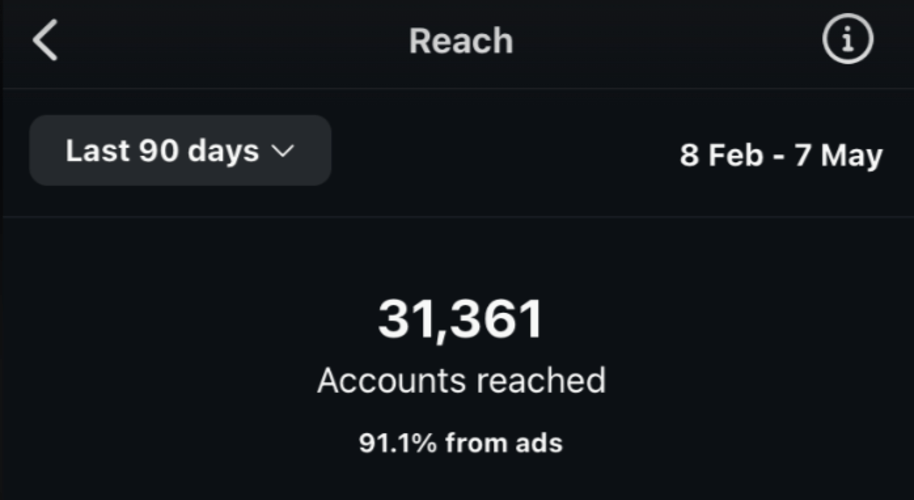
However, social media reach is just the tip of the iceberg.
If you want to make reach metrics matter, you must get the full picture of how your message speeds online.
And it gets more complicated to measure it for non-social reach.
You’ll need advanced media monitoring tools to do that accurately.
Brand24 can monitor social media (Instagram, LinkedIn, X, Tikok, YouTube) and non-social (from news, forums, blogs, and podcasts) reach and present this data in a simple way.
I asked the tool for data about Spotify, and this is a general overview of its reach:
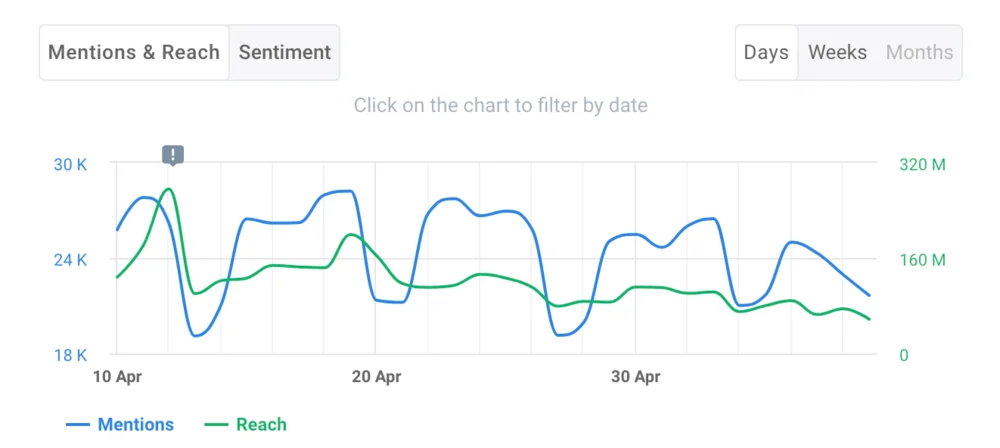
I can also manually filter the results and get the analysis of a specific source.
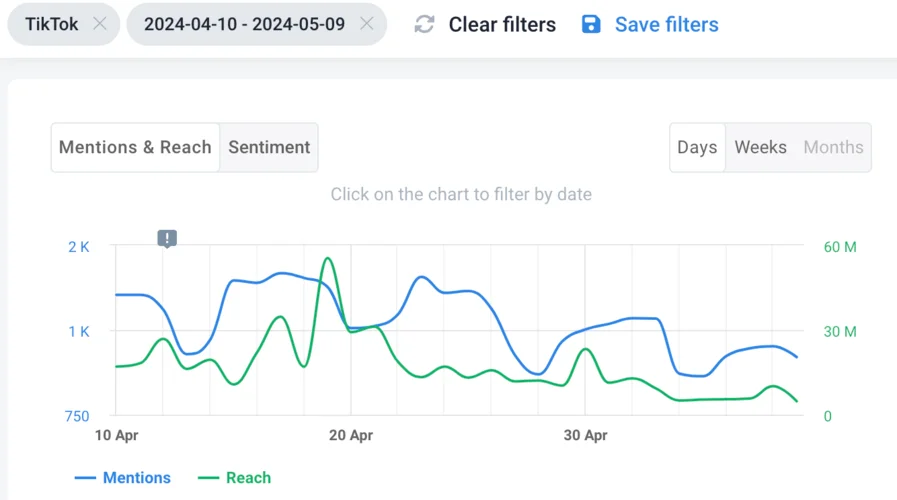
It’s a useful feature for getting details, but if you want to understand the reach in general, go for the AI functions.
I went to the “Metrics Analysis” tab and received amazing social media insights!
With just one click, I have the most reach efficient source and an amazing project summary:
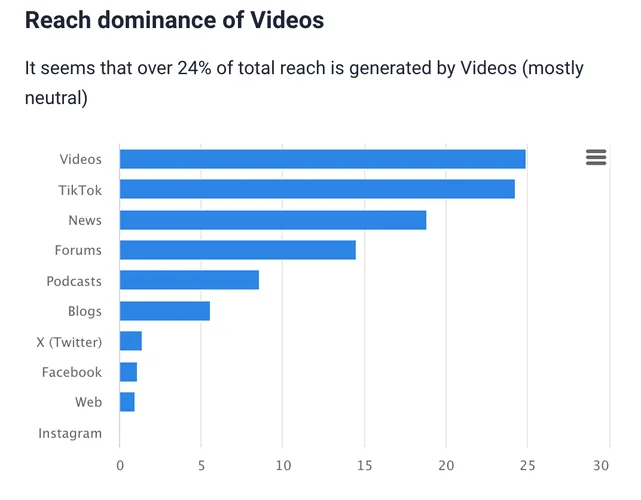
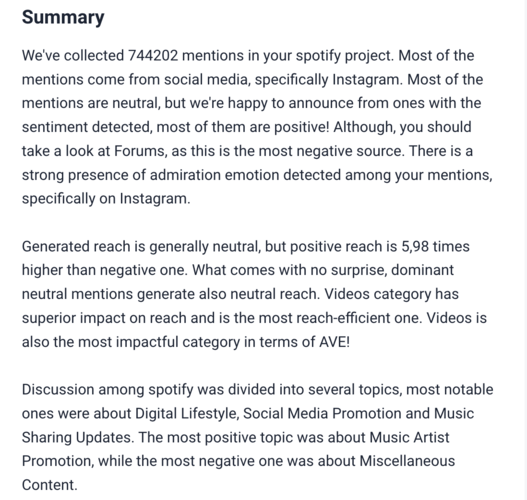
02 Impressions
Impressions count the total number of times your content has been seen. This metric is important because it gives you a sense of how attractive your content is.
High impressions lead to increased brand awareness and indicate engagement potential.
You can find stats related to your impressions in the social media analytics tools tab.
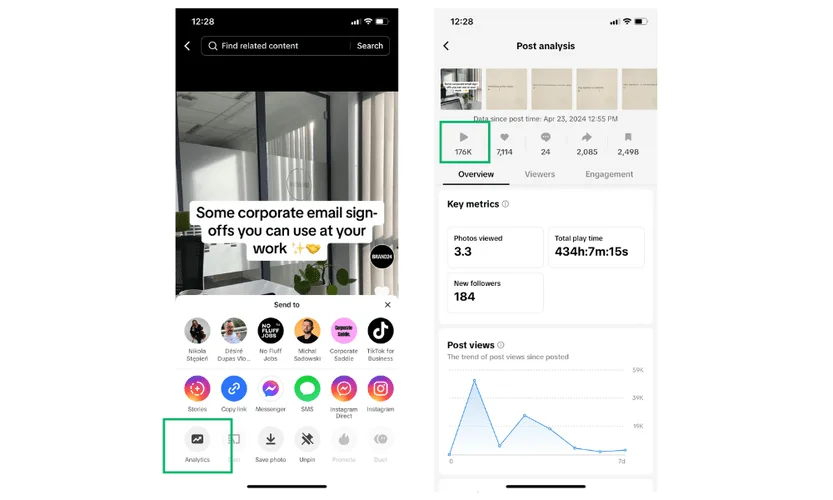
The difference between reach and impressions can be tricky.
But here’s an example:
I loved TikTok and rewatched it 4 times.
This means that my views will count as four impressions… But I’m the only one who created those four vies, so I will still be just one person reached.
💡 It’s important to track both to improve your brand’s popularity and image.
02 Engagement Rate
Engagement rate shows how well your audience interacts with your content through likes, shares, comments, and clicks.
A high engagement rate suggests that your audience finds your content valuable. It indicates loyalty and trust.
It is crucial because it reflects directly how effectively your content resonates with your audience.
To measure the average engagement rate use this formula:
[total engagement (every like, share, and comment) ÷ by total views] x100
03 Followers Growth
This metric tracks how many new followers you gain over a given period. It’s a good indicator of how your online community is growing!
Tracking this helps you understand the growth of your community.
A growing follower count indicates increasing interest in your brand, which can directly result from successful marketing strategies.
You can find data about your audience’s growth rate using the app analytics tools.
Just go to your profile and look for the “analytics” or “insights” tab.
This is what it looks like for the most popular social media channels:
- Instagram:
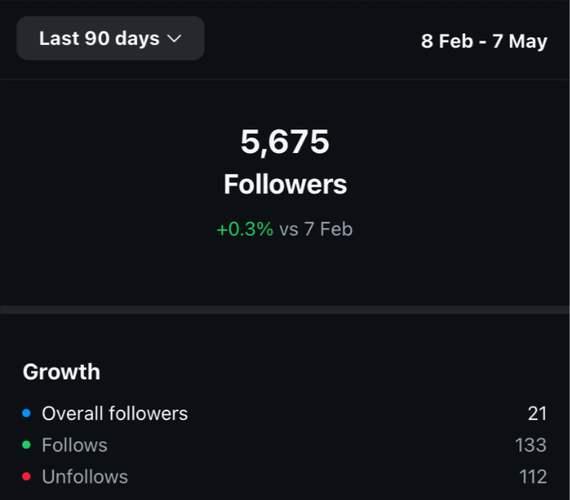
- LinkedIn:

- Facebook:
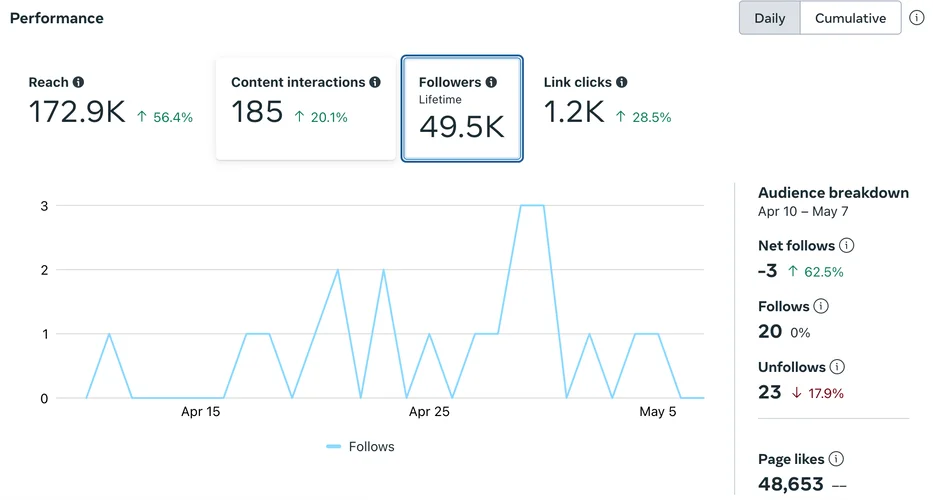
04 The volume of mentions
The volume of mentions is a key social media metric that tracks how often your brand is talked about online.
Simply put, it measures how frequently people mention a specific keyword (your brand name, hashtag, campaign slogan) across the web.
This metric is essential for understanding your social media performance analytics.
Thanks to tracking mentions, you will find out:
- Which social media platform is generating the most mentions of your brand?
- What topics or content types get your audience to discuss your brand?
- Opportunities to enhance your SEO through potential influencer collaborations.
Using a specialized media monitoring tool is the most effective way to keep tabs on brand mentions.
Social listening tools like Brand24 track the volume of mentions and, thanks to AI technology, provide you with a ready-to-use analysis.
You can access information about:
- Which platforms are driving most of the conversations?
- What emotions do they associate with it?
- Which source generates most of the negativity?
This information shows where the brand’s engagement strategies are most effective and can help guide future social media marketing efforts.
For example, for Spotify, Instagram generates the most conversations.
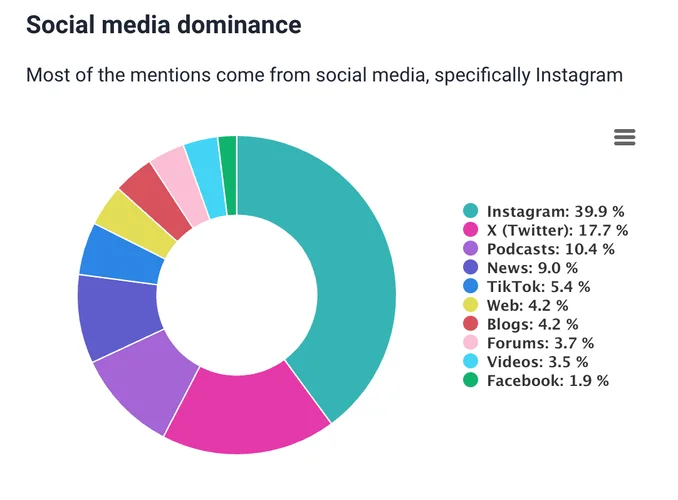
And it is also the source of most of the positive emotions:
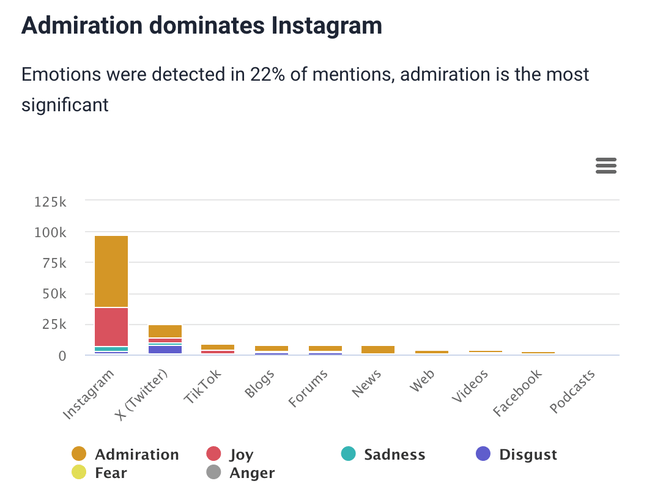
Another important feature is the negativity detection. For Spotify, the main source of negativity is Forums.
Perhaps it’s time to do a special campaign there?
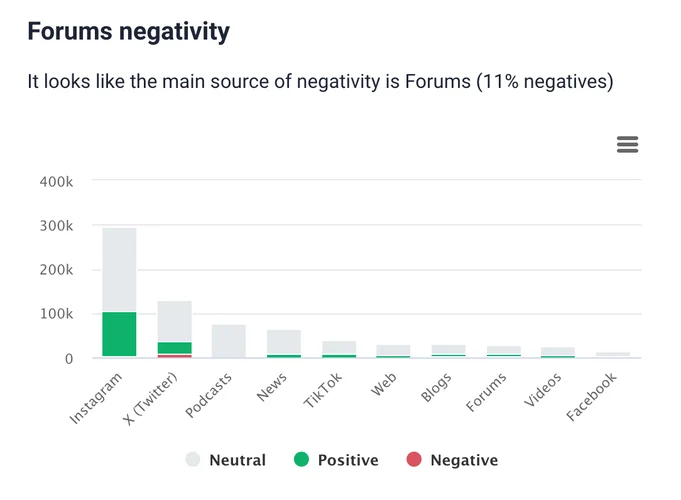
And this is an overall look at the Spotify’s mentions:
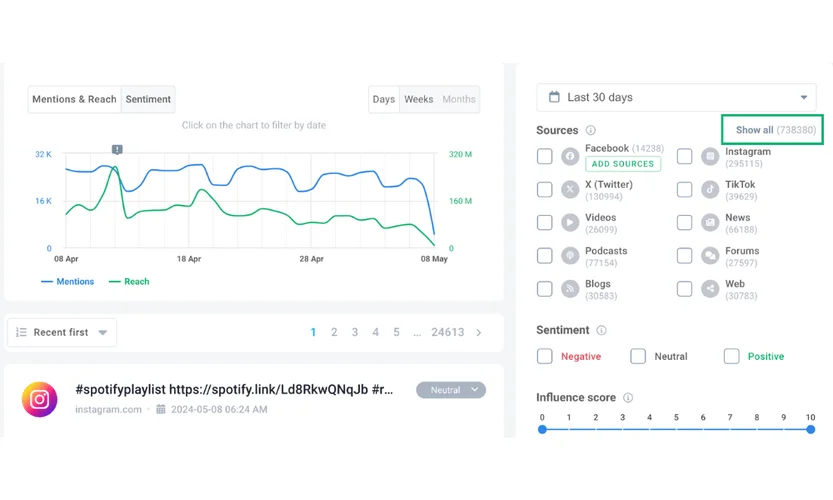
03 Share of voice
This social media metric compares your brand’s market visibility to your competitors.
A higher SOV can indicate a stronger market presence and influence.
Share of Voice (SOV) is an essential social media tool for anyone serious about social media performance. It shows how much your brand stands out compared to your competitors, helping you understand your position in the market.
Brands don’t operate alone. Knowing your SOV helps you see how your brand measures up against others, evaluates the effectiveness of your social media strategies, and compares your social media marketing with those of your competitors.
Thanks to measuring the share of voice, you will find out:
- How well your social media campaigns perform.
- Which social media channels boost your brand, and which ones need more work?
- What tactics are working for your competitors and might work for you, too?
If you want to dive deep into understanding your social media impact – it’s time to start monitoring your Share of Voice.
Using AI-powered tools like Brand24, you can quickly get an idea of how often your brand is mentioned.
It couldn’t be simpler to stay ahead in the game!
As we keep talking about Spotify – let’s stick to it.
I’d like to compare how their SOV looks compared to one of their most important competitors – Tidal.
I go to Brand24 > “Comparison” and select the projects to compare.
This is what I got:
- Spotify clearly leads with a wider reach on social media. It means their content and social media campaign hits a broader audience.
- When it comes to social mentions, Spotify also maintains a higher volume compared to Tidal. This indicates that people talk about Spotify more frequently.
These insights reveal that Spotify’s social media efforts are more effective, giving it a stronger presence and influence in the market than Tidal.
For anyone keen on boosting their social media marketing – observing these metrics can highlight which channels are working well and what competitive tactics you could potentially use.
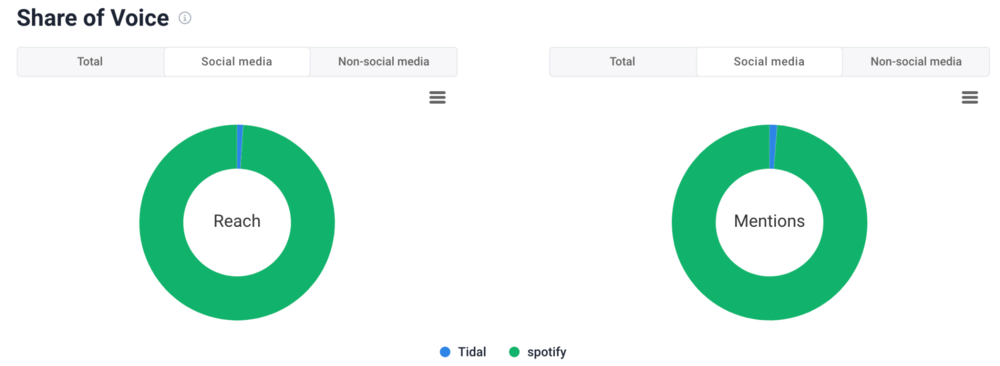
05 Video Engagement Rate & Watch Time
Short video engagement is an important factor in your social media performance.
Would you rather look for product reviews in the form of an article or video?
In fact, 75% of people prefer video over text for learning about products or services.
Short video engagement tracks how much people interact with your videos via TikTok, Instagram Reels, or YouTube Shorts. This includes views, likes, comments, and shares.
Why focus on short video engagement?
- Engaging videos are shared more, helping your content reach more people.
- Videos with high engagement help more people notice your brand.
- Interesting videos make viewers want to engage more with your content, like visiting your website or asking about your products.
It’s important to monitor how your short videos are doing. Pay attention to:
- Watch time: How long do people watch your videos?
- Interaction rates: How many viewers like, comment, or share your videos.
- Video completion rate: How many people watch the whole video?
- Click-through rates: How many viewers visit your website or follow your call to action after watching.
Understanding these details helps you make better videos that people want to watch and interact with, boosting your social media results.
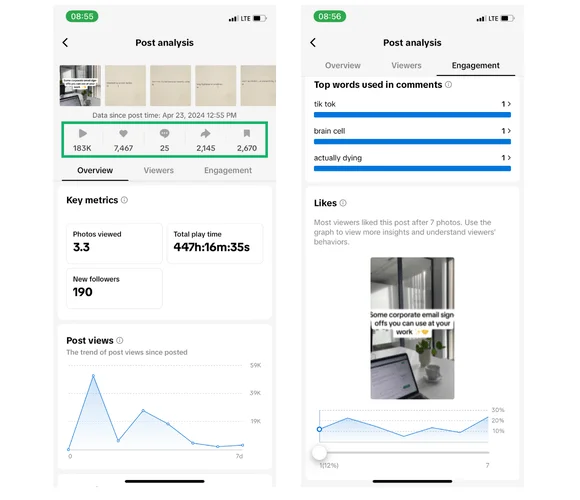
07 Click-Through Rate (CTR)
Click-through rate (CTR) measures how often people click on a link in your post compared to how often it’s seen.
A high CTR means that your content is noticed and prompts action. This indicates driving traffic to your site or conversions.
When the pandemic started, I decided to be more creative and sell totes with my art.
I even ran an Instagram account for this small business and did several mini social media campaigns.
It was more about the fun and less about the profit… but I think it perfectly illustrates the CTR.
One of my posts reached 36 people, and 15 of them clicked on the link to buy. This gave me a CTR of around 40% (15 clicks / 36 views x 100).
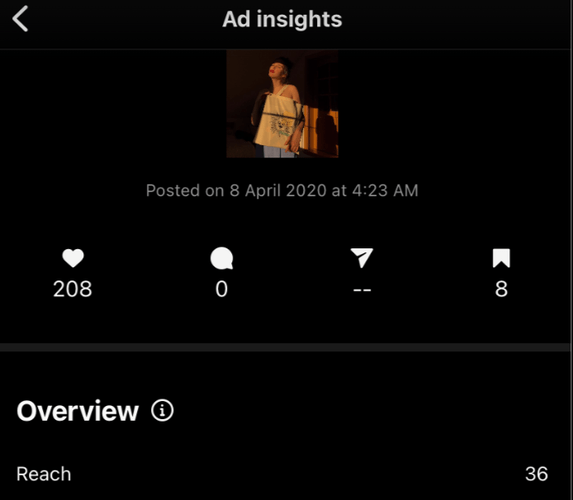
08 Presence Score
Online Presence Score is valuable because it quickly rates your social media performance strategy.
It is an overall rating of how visible your brand is online.
A higher score means you’re more noticeable in the digital crowd.
Thanks to measuring Presence Score, you will find out:
- Whether your brand awareness is increasing or decreasing
- The significant impact of events on your brand’s popularity
- Whether it’s time to reassess your PR strategy
Below, you can find Spotify’s Presence Score and how it has changed over the last three months.
As you can see from the chart below, Spotify usually has a very high Presence Score of 96.
It shows that it’s very popular online.
But, there was a small drop in the score around late February before it went back up.
If I were in charge of Spotify’s social media, I would look into what caused that drop and consider adjusting social media strategy to keep Spotify’s popularity from falling again.

09 Reputation Score
Monitoring the Reputation Score is the easiest way to keep up with your social media performance.
Reputation Score reflects the public’s overall perception of your brand.
By tracking this score, you gain valuable insights into how your brand is viewed across different platforms and by different audiences.
This metric is crucial because it directly impacts customer trust and loyalty, influencing their decisions to engage with and promote your brand.
Thanks to measuring Reputation Score, you will find out:
- Brand health
A high Reputation Score indicates healthy brand perception, suggesting effective social media strategies and strong customer loyalty. - Areas for improvement
A lower score highlights areas where your brand may need to adjust its approach, whether in customer satisfaction, content quality, or public relations strategies. - Impact of campaigns
Changes in your Reputation Score can help you understand the impact of specific campaigns or events on public perception. This knowledge allows you to tailor future social media marketing for better results.

10 Sentiment
Sentiment analysis lets you peek into how people feel about your brand based on what they say online.
Are they positive, negative, or neutral?
By understanding the sentiment behind the conversation, you can quickly spot potential PR crisis, calm down upset customers, and see which of your marketing efforts are hitting the mark.
This is an invaluable tool for boosting your social media performance!
Thanks to sentiment monitoring, you will find out:
- Discover which social media platforms are giving you thumbs up and where you might need to improve.
- Learn how your audience reacts to your campaigns. What excites them? What might be turning them off?
- Identify early warning signs of trouble and know when to adjust your strategies to keep your social media audience engaged and happy.
How to track the sentiment of your brand? Again, with an advanced social listening tool.
Brand24 lets you see how people feel about your brand in real time.
Plus, you can use different filters to:
- Find out the sentiment in posts on specific social media platforms.
- Browse only positive or negative mentions.
- Check how the sentiment changed over a specific period of time.
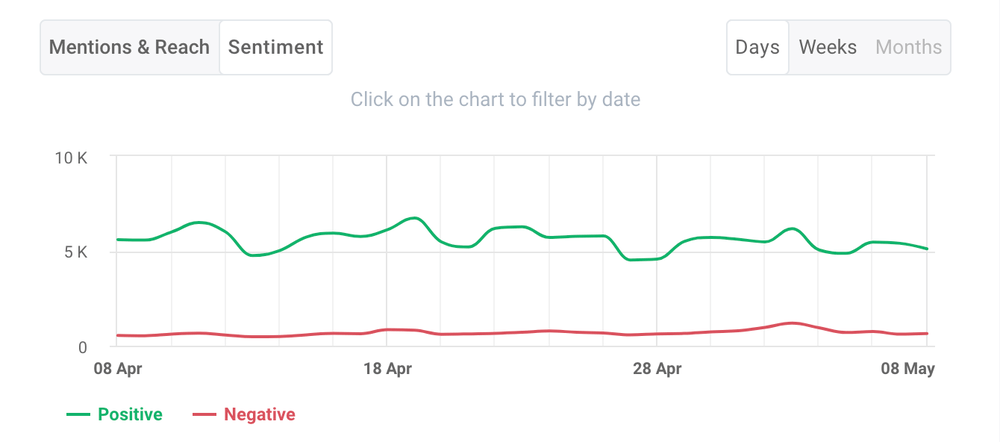
I especially recommend opting for an AI-powered tool as it will analyze the data for you.
It saves a ton of time!
Thanks to AI technology, Brand24 can dive deeper and detect the actual emotions behind your brand’s sentiment.
The tool can detect:
- Admiration
- Fear
- Joy
- Anger
- Sadness
- Disgust
And provide you with a detailed breakdown of those emotions from each source.
For Spotify, admiration is the most popular – good job!

But even though admiration was the most significant, if they are sad – where does this come from? You can quickly find the platform with most of the negativity and learn what caused the problem.
No more guesswork!

Tip: Benchmark the social media performance
Think about running a race without knowing the time or seeing the other runners. How would you know if you’re ahead or need to speed up?
That’s why I recommend regularly benchmarking your social media performance. It’s like finding a reference point.
Why should I benchmark my social media performance? Here’s a list of benefits:
- Track how far you’ve come and where you must go to hit your goals.
- Discover what strategies work for your competitors, and consider how to use similar approaches.
- Focus your time and budget on what truly works, reducing wasted effort.
- Keep up with the pace of your industry and ensure you’re not falling behind.
How to find a reference point for your social media marketing?
You can use the Comparison tab by Brand24. It quickly analyzes your key metrics and gives you a chart like the one below:

As you can see, Spotify’s performance has slipped since the last period.
While the brand is still doing quite well overall, there’s a clear drop in how often people mention and reach out to it.
I suggest that Spotify should really think about a new campaign to raise brand awareness and maintain a positive image.
By boosting its visibility and engagement now, Spotify can get back on track and keep its impressive performance going.
Conclusion
Do you still need to determine whether it is worth tracking social media performance?
Knowing whether your marketing efforts are successful or falling short is nearly impossible without social media monitoring. Analyzing and adjusting your strategy based on the right metrics is key.
In the digital age, data is king.
By leveraging AI-powered tools like Brand24, you can gain insights into how your brand performs across various platforms.
You can respond to trends, engagement levels, and audience sentiment in real-time.
Final thoughts:
- Regularly checking your social media performance helps you make better decisions. This way, you know your strategies are tuned to what your audience wants now (not last month).
- Keep an eye on what your competitors are up to on social media with benchmarking. Learn from their wins and their losses so you can stay ahead!
- Put your time and money into social media campaigns and strategies the data shows are working. It cuts down on ad spend and boosts your return on investment.
Want to maintain a strong, positive brand presence? Start with a Brand24 trial.


